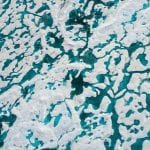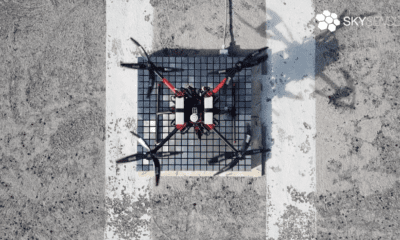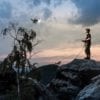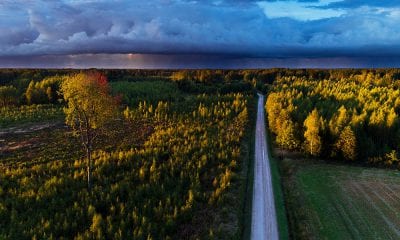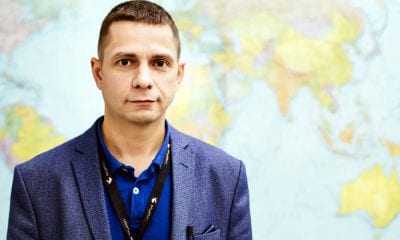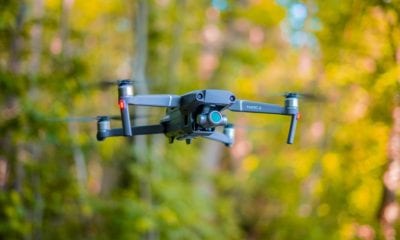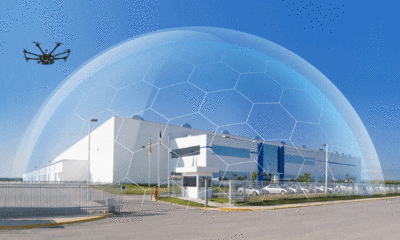High Flyers
The Arctic Unveiled and That Polar Bear With Aerial Photographer Florian Ledoux
Sometimes a photo is just a photo – but other times, a photo is so much more than this. It could capture a moment that evokes deep feelings, tells a courageous or heart-breaking story. The photographer who has the passion and mettle to catch these moments can lift us to something higher, make us think deeper and inspire us to do better. Such is the case with French photographer Florian Ledoux, who recently won the Grand Prize for Professional Aerial Photography in the Story Photo Contest of 2017 by SkyPixel for this image. He was also shortlisted for 2017 National Geographic Nature Photographer, and has been featured in the National Geographic magazine alongside the likes of photographer and conservationist Paul Nicklen. We tracked Florian down to uncover some of the story behind his two of his passions: aerial photography and the Arctic Circle.
First of all, congratulations on your recent award with SkyPixel! Before you took up drone photography, you were a photojournalist for the French Navy. How has this experience led you to your current focus, capturing the Arctic and its wildlife?
Thank you! I have been in the Arctic for the first time when I was 11 years old, since that time it has never really left me. The Navy allowed me to have lot of free time which I spent traveling in the north. From step to step a bit further in expedition I ended in Greenland and then Nunavut. From the beginning it was totally for photography purposes. Landscapes, then human reports on Inuit culture and nowadays Arctic Wildlife as you can see.
For what reason did you make the decisions to expand your skills into drone photography?
I was definitely looking for a new point of view, an idea to bring fresh images on species we already known. Every time the drone took height, I could not believe the unique wilderness and untouched nature I was seeing. I believe drones allow me to capture a brand new style of wildlife images in the Arctic. All the animals I photographed are icons of the Arctic, and because of the remote places, harsh conditions, and difficulties to find the animals, it makes the photographs unique.
- Above the Walruses | Florian Ledoux
- Beluga Pod | Florian Ledoux
- Narwhal from Above | Florian Ledoux
- Narwhal Hunting | Florian Ledoux
- Walruses on Beach | Florian Ledoux
- Above Belugas | Florian Ledoux
- Arctic Fox | Florian Ledoux
What challenges do you face in the Arctic with regards to drone piloting and photography?
Flying here above the 74° North is totally different and this is even truer when you want to approach wildlife. I often did a first approach of the animals ashore. During this eight weeks, I studied the natural habitat and learned about the behaviour of these animals, and started to document them. I spent up to 8 hours to approaching ensuring the animals not being threatened by my presence. Only after this time spent with the animal I flew the drone. The result is that we can see on different photographs as video footage that the different species are not stressed by my presence and the drone. I ended quite close to the polar bear and he didn’t really care. Now I am ready to try the Inspire 2 model mounted with a Zenmuse X7 camera on it!
Your motto is “To see, witness and protect”. Please share with our readers about your passion for the Arctic and how drone photography assists your mission?
I want my photo to serve wildlife conservation. So for that I need to see, than capture the moments that bring out a stories, and I can final contribute to protect the wildlife in the Arctic.
When I find myself in the remote Arctic, encounter and engage with the people and wildlife that call it home, I know that this is the moment where everything makes sense for me. I know it because I feel it deeply in myself. It is a deep vibe that take my all body and soul. In this moment, the urge to create an image that I would remember for the rest of my life with a strong message, comes naturally to me.
Those moments are incredible to me, something is happening within me. It’s what I live for. When I photograph, I’m somewhere else. This is, I guess, passion.
Do you have any images of which you are particularly proud? What makes them stand out?
There is one I am definitely proud is the one right above the polar bear crossing the sea ice in summer. More than the composition and technical setting that were pretty hard, more than the beauty of the polar bear, it is the strong message that ice is melting. Otherwise all the other wildlife photo from the drone I am very proud of it as well as they show species from a new point of view.
- Above the Polar Bear | Florian Ledoux
- Sea Ice in Summer with Polar Bear | Florian Ledoux
- Polar Bear Resting on Ice | Florian Ledoux
- Polar Bear on Ice | Florian Ledoux
- Polar Bear Hunting | Florian Ledoux
Can you share any interesting or challenging moments from your Arctic photography missions?
The night before, at the end of Tremblay Sound, we encountered a dead narwhal ashore and while approaching it we saw fresh polar bear tracks.
We felt confident that the majestic animal would return to the site so we decided to take watch between us throughout the night. The next day however, we had to leave due to or sailing plan and rapidly changing ice conditions in Lancaster Sound.
When sailing towards Eclipse Sound, at the outlet of Tremblay Sound, we saw a huge piece of sea ice which was almost closing the fjord. From experience we were confident that it had to be the proper place for polar bears to hunt. Very shortly after we arrived we finally spotted the first bear hopping from ice sheet to ice sheet looking for seal. As we observed the first bear, three more bears made their appearance at the same sheet of ice.
Once I got the images I was on the deck super cold because I didn’t have time to get properly equipped, and I was super stressed. The mission was to land on board without losing the drone. I even thought if I have to lose it I will crash on deck so I can get the images… I knew from the beginning these images would have great success and travel. Once the SD card was in the computer I got even more excited but after the job was done I totally tired and collapsed! That was a fantastic day and will change my photographic career.
- Sea Ice Formation | Florian Ledoux
- Glacier From Above on Devon Island | Florian Ledoux
- Devon Island Empty of Ice | Florian Ledoux
What do you fly, and what do you love about it?
I am flying a Phantom 4 Pro+ now. I have had Phantom 3 Pros before but crashed many of them. I love the quality of DJI drones! Despite the troubles they are really strong and well designed for photography and video.
What would be your next drone purchase? Why?
I have dreamt for a long time about the Inspire 2! It can handle the Arctic conditions better and fly at -40°c while the Phantom 4 pro was rated for 0°c… Now that I own the Inspire 2 with the Zenmuse X7 cine camera, thanks to DJI and Skypixel, I will see the limit of this drone but I think I will have it for a long time since it is at the higher end of the market you can find for this type of drone. It is like my Nikon D5!
Do you have any other locations you’d like to shoot from the air? Why?
I have many locations that I want to shoot from the air, but it is mainly wildlife now that I want to capture. Wildlife behaviours, the action is right from above!
How do you see the drone technology expanding or changing in the next 5 years?
We already reached a level of incredible images and accessory quality! I think they will become more and more reliable and solid. Also it would be nice to save everything on the ground while flying so if you lose it in the sea you don’t lose your images… (That was my case).
Where has your passion for the Arctic taken your photography career?
Before the expedition, I was super excited and inspired to produce more thanks to the 3rd place received from Dronestagram and National Geographic at their International Drone Photo contest.
But it went further when I came back as I got an article about the wildlife report in Nunavut.
Later the greatest honour came to me when I was featured in National Geographic Magazine over three pages, in an article called “Last Ice” with Paul Nicklen, the great photographer and co-founder of Sea Legacy.
More recently I won the “Grand Prize” for Best Drone Photography 2017 by Skypixel/DJI. This is for me just incredible.
What does the future hold for you?
After the reconnaissance journey of this summer in Nunavut, I have a strong desire to go back at different times of the years to create drone images of the wildlife. A long term project is to publish a book “Aerial Arctic Wildlife.”
In the meantime, my partner (an arctic guide I met while we both worked independently in Greenland) and I, are creating our own travel company Nordbound, offering photography and educational drone tours in the Arctic.
Where can readers find out more about what you do?
Readers can see more on www.florian-ledoux.com, or simply on Facebook or Instagram. They can also read the story about the summer expedition on National Geographic.

About Florian Ledoux
“Photography has always been my way of expression; it gives me a different perspective on the world, a new way to observe my surroundings and especially the means to capture moments of life to share with others”.
During my childhood, my parents gave me a taste for travel and raised me see differently, and to observe the Earth without knowing that I will find in it my life power.
During my expeditions, it is as an autodidact that I made the first steps of photographer. I finally found my photographic identity after following the path of photographic reporter for the French Navy.
Through my passions: photography, sport, traveling, hostile environment survival, I forged a life experience that allows me to transcribe forcefully the emotions that can arise in us through the beauty of nature and peoples of the North.
I am always in search of places where nature reigns, where the colours of the earth are never the same, where men have a history, where meetings forge the spirit, alone or accompanied. I travel the world to share this passion with all of you and above all, make you aware of nature’s fragility.
More from Florian Ledoux
Error: No posts found.
Make sure this account has posts available on instagram.com.
Error: admin-ajax.php test was not successful. Some features may not be available.
Please visit this page to troubleshoot.










